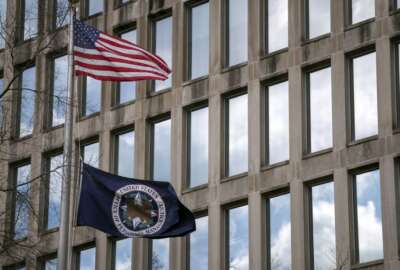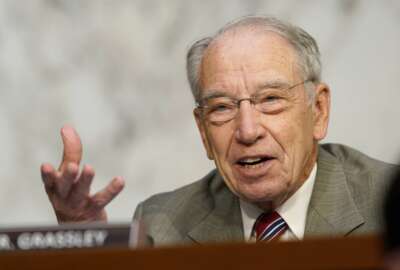Hubbard Radio Washington DC, LLC. All rights reserved. This website is not intended for users located within the European Economic Area.
Government Contracting Myth No. 1: We should never protest
In the first part of a 10-part series on government contracting, expert Tim Sullivan says even if a company has a no-protest policy, it is naïve to believe tha...
Commentary by Timothy Sullivan
Partner, Thompson Coburn, LLP
This column was originally published on the Public Contracting Institute’s website and was republished here with permission from the organization. This post is the first in a 10-part series, “Ten Myths of Government Contracting” and will be released weekly on Federal News Radio.com.
Bid protests are an intimidating aspect of government contracting, not only because they usually mean hiring a lawyer, but also because most people don’t even like the thought of suing their customer. Protests certainly are not part of the commercial business sector, but they are a daily occurrence in government contracting, and anyone jumping into this business needs to understand how protests work and the role they play.
Most protests relating to a U.S. government procurement may be filed in three separate places — with the agency, at the Government Accountability Office (GAO) or at the U.S. Court of Federal Claims. Some agencies, such as the Federal Aviation Administration and the U.S. Postal Service, have their own protest procedures and forum.

Each forum presents different characteristics and prudent companies select their forum after consulting experienced counsel. While we do not have any statistics on the success rate for agency-level protests, the GAO’s statistics are published annually. For the fiscal year completed on Sept. 30, 2013, for example, the GAO closed 2,538 protests, issuing decisions in 509 of them. The GAO sustained 17 percent of its protests on the merits. But the GAO has another statistic that is perhaps even more important — the “success rate.” In the fiscal year ending Sept. 30, 2013, 43 percent of the protests filed at the GAO resulted in corrective action. These statistics show that there are a lot of companies filing protests, these protests are often effective and they deserve a second look if you have shied away from them in the past.
There are essentially two kinds of bid protests: those that challenge the terms of a solicitation and those that challenge an agency’s award to a competitor.
With respect to the first type, it is critical to understand that any challenge to the terms of a solicitation must be filed before offers are due. Many companies spot problems in the solicitation, such as specifications that are tailored to a competitor’s product, but decide to hold off on filing a protest until after the results of the competition are announced, hoping they will win and reasoning that they have a solid protest issue in their back pocket if they lose. Their rationale is simple: let’s not rock the boat. Of course, the fact that the solicitation was written around a competitor’s product was a pretty clear message that they weren’t even in the boat. And if they do file this kind of a protest after the award has been announced, it will be dismissed as untimely, an argument every government lawyer has mastered.
Here is what experienced companies do.
First, they review a solicitation thoroughly and they make notes of any troublesome areas.
Second, they try to resolve any ambiguities, discrepancies or contradictions by applying the “Order of Precedence” clause in the solicitation.
Third, they prepare a list of questions to submit to the agency contracting officer, and they either submit them by the deadline for questions set forth in the solicitation or early enough so that the agency will have a reasonable amount of time to answer the questions (in other words, they don’t wait until the last day).
Fourth, if the agency refuses or fails to answer the question, or responds in an unsatisfactory way, the company must decide whether to (a) take a pass on the opportunity; (b) submit a proposal in spite of the risk; or (c) file a protest. This is primarily a business decision, but it should be made with the benefit of advice from experienced counsel.
Listen to Tim Sullivan’s interview with Federal Drive host Tom Temin.
The second type of protest, challenging an agency’s award to a competitor, usually focuses on whether the agency’s actions were consistent with the terms of the solicitation and whether the agency complied with the applicable regulations. In order for this kind of protest to succeed, a protester must show a material deviation from the solicitation or the regulations, and it must also show that it was prejudiced by the agency’s actions. As part of that challenge, a protester must realize that agency contracting officials are given wide discretion in the execution of their duties, and the GAO and the courts do not like to substitute their judgment for an agency official’s judgment, but they will if the facts demand it.
In most negotiated procurements, a protest cannot be filed until after a disappointed offeror has received its debriefing. This is a critical step in the process and experienced contractors know that they should file a written request for a debriefing immediately after learning they lost. They also know that they must prepare for a debriefing, understanding what they are entitled to learn and preparing questions they want answered. The completion of the debriefing triggers the short protest time period, and every day counts.
While the regulations state that a protest must be filed at the agency or at the GAO within 10 calendar days after the basis for the protest was known or should have been known, the fact is that most companies, especially incumbent contractors that just lost on a re-compete, want to file at the GAO within five calendar days in order to maximize the chance that the contract at stake will be “stayed” until the protest is resolved. The U.S. Court of Federal Claims does not have a similar filing deadline, but judges there will not look kindly on a company that drags its feet in getting to the courthouse.
Even if a company has a no-protest policy, it is naïve to believe that it can completely insulate itself from the protest process. For example, what happens when a company is awarded a large Navy contract and learns two weeks later that a disappointed competitor has filed a timely GAO protest? Should the company’s CEO just start to pray and hope for the best, or should the company intervene in the protest in order to understand what is really at issue and try to defend the award? Once again, consulting with experienced counsel should yield the right answer.
As a vivid reminder of how important the protest process can be, think back to early 2008 when Boeing learned that the Air Force had awarded a $30 billion contract for a new aerial refueling tanker to Boeing’s rival EADS North America. After its debriefing, Boeing filed a GAO protest, and some 100 days later the GAO issued a decision sustaining the protest and ordering the Air Force to take corrective action. The Air Force conducted another round of offers, and in February 2011 Boeing emerged as the winner. Without the protest process, EADS and its teammate Northrop Grumman would be performing that contract in Alabama today.
Of course, not all contracts are going to be that large or garner that much publicity, but the fact remains that most experienced government contractors understand that situations will arise when they are left with no choice but to file a protest.
Tim Sullivan is the chair of Thompson Coburn’s Government Contracts Group. He can be reached at tsullivan@thompsoncoburn.com or (202) 585-6930.
Copyright © 2024 Federal News Network. All rights reserved. This website is not intended for users located within the European Economic Area.
Related Topics




